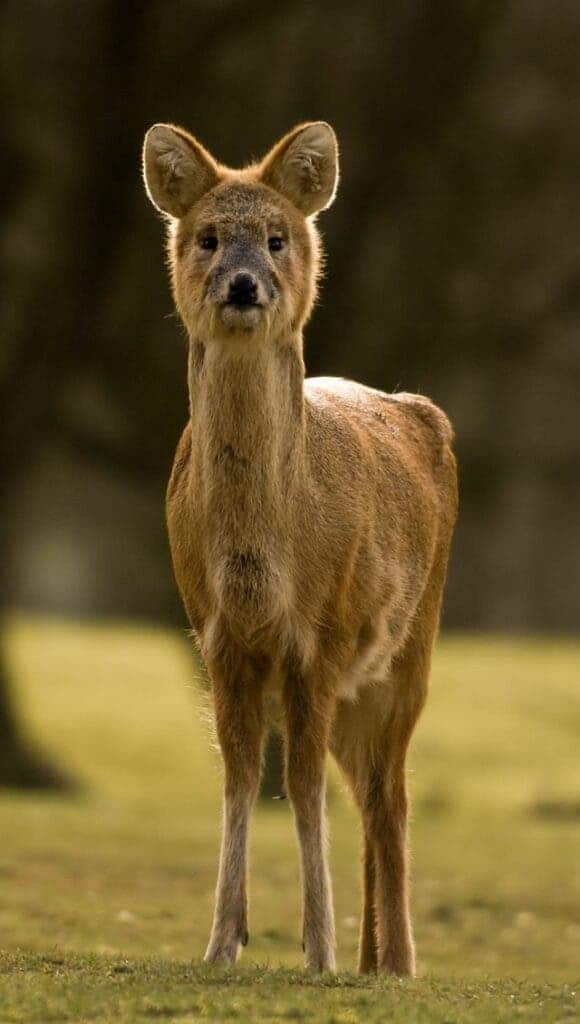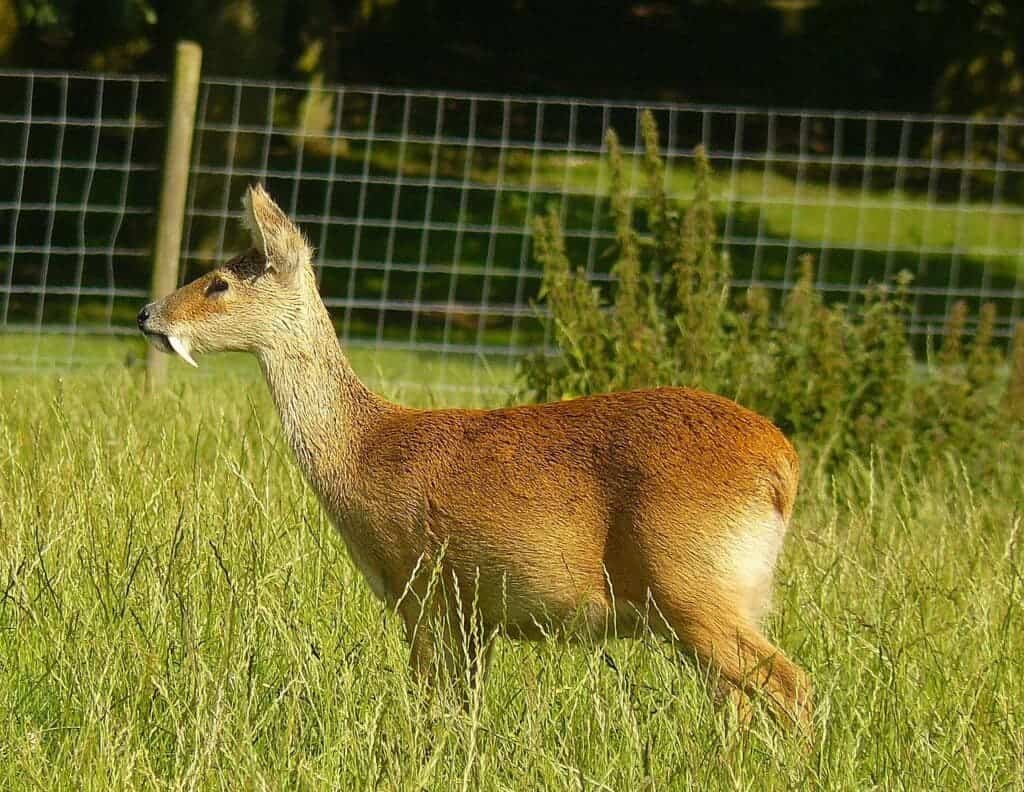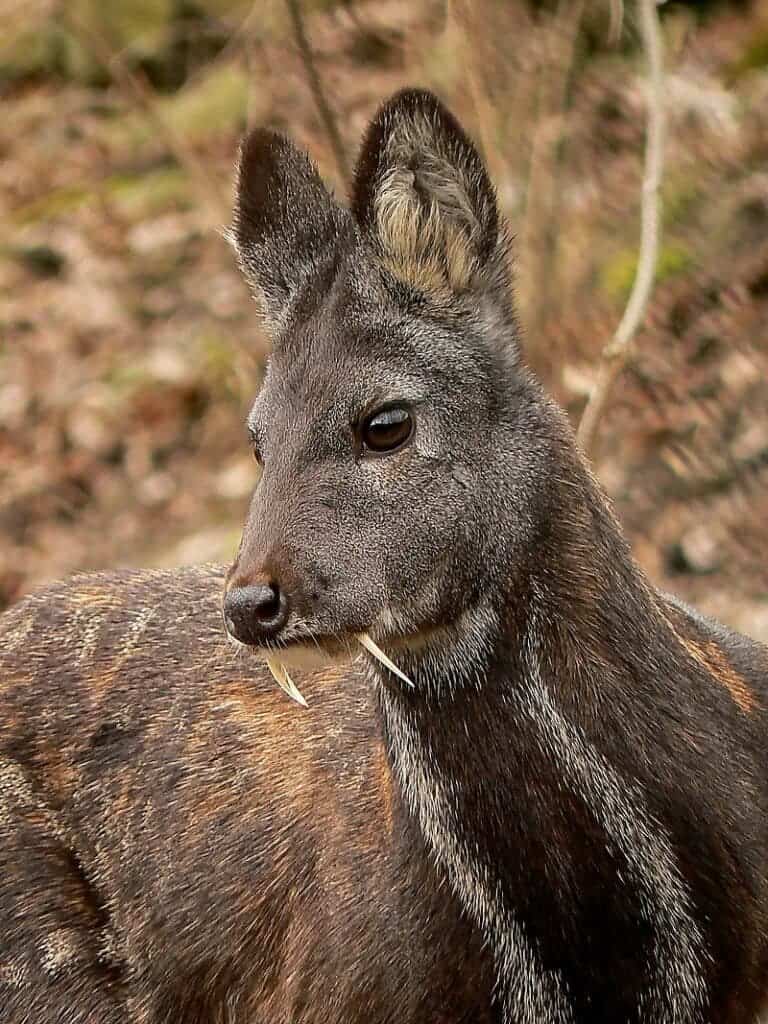Everyone knows you tell deer apart by their antlers, right? Well, imagine cute, adorable Bambi — but with no antlers and fangs. It could be quite hard to picture the two together, but such a creature is not only possible, but actually exists. Vampire deer, as they are called, are not mythical creatures but rather deer that possess prominent upper canines.

Goofy but intimidating
Big, vampire-like fangs is not exactly what you expect on a herbivore, let alone one that would be so goofy-looking, so what gives?
Vampire deers belong to the order Artiodactyla alongside other even-toed ungulates like giraffes and camels as well as whales. Yes, whales belong to this order according to recent molecular data, but that’s a story for a different time.
What we commonly call “vampire deer” actually refers to species that can be found in two families: Moschidae (or musk) deer and Cervidae (or deer). So the term vampire deer (or “fanged deer, which is also used sometimes) is actually a pretty vague one that can refer to several different species.

There are seven species of musk deer all of which live in forested and alpine scrub habitats in Southern Asia –specifically in the Himalayas. They are entirely Asian in their distribution but Oligocene fossil records revealed that the earliest musk deer exist in Europe. Meanwhile, there is only one species of water deer with a limited distribution in Korea and eastern China.
Bizarrely, some vampire deer can also be found in the UK — but due to unnatural reasons. In the 1890s, Herbrand Russell, the 11th Duke of Bedford, brought a family of Chinese water deer (Hydropotes inermis) from the banks of the Yangtze River in China to the English countryside. Ironically, this act saved the species: at one point, the species went extinct in China and the only surviving herd was in the UK, so it turned out to be a successful conservation story.
However, some of the deer escaped the estate and made small areas of the British countryside their own, where they are hunted for sport (although the species is still considered vulnerable to extinction). In Asia, the biggest threats to vampire deer are commercial development, agricultural expansion, hunting, and severe storms and flooding caused by climate change.
Because the Chinese water deer is so adaptable, it can also be found in Argentina and even some parts of the U.S. They were also introduced as a feral population to France, but there have not been any sightings of the animal since 2000 and the herd is presumed to be gone.
Fear not the fangs
Both musk deer and Chinese water deer do not bear antlers or horns and, seemingly to compensate for the lack of it, they grow impressive fangs. The upper canines of male deer form long (up to 10 cm) downward-pointing tusks. They stick out on both sides of the mouth like fangs making them look like vampires.
However, these fangs are just for show as both deer species do not use it for any sort of carnivorous behavior. Rather, it is for defense against other males or predators just like how antlers are used by other deer species. During the breeding season, male deer will grow tusks instead of antlers. This makes sense as the dagger-like tusks are the most effective weapons in thick underbrush compared to antlers that are more prone to entanglement in bushes.
If that doesn’t convince you this species is harmless, you should know that while vampire deer may look ferocious in photos and descriptions their size can be quite underwhelming, with a body length of only 2.5–3 feet (0.75–0.9 meters).

Though similar in many ways, musk deer and Chinese water deer also have notable differences. Chinese deer can live in wetlands and marine intertidal zones, they are excellent swimmers and are able to swim several kilometers in search of food and shelter. This small, compact deer is also extremely territorial — males mark their range with dung piles and also rub their glandless foreheads (which still leave a scent) against trees. When alarmed, they make a harsh warning bark and eventually make a shrill shriek.
Unlike the water deer, musk deers are well-adapted to a leaping form of locomotion. They are agile and well-adapted to steep slopes and uneven terrain. This shy deer relies on its sense of hearing to be alerted to any nearby threats.
Killed for traditional medicine
Interestingly, all male species of musk deer possess a gland in their abdomen that secretes a pungent, waxy substance called musk. Musk is used in many traditional East Asian medicines to aid in treating diseases relating to the heart, nerves, and breathing. Moreover, it is also utilized in cosmetics, shampoos, and detergents thereby increasing demand for this scent — which is also adding to the list of threats to this species.
Though musk can be extracted from live animals, musk deers including females and juveniles which are devoid of any scent glands are typically caught and killed in snares. This has resulted in a dramatic decrease in their population and all species are now listed in CITES Appendices I and II, meaning their populations are declining at an alarming rate and are at risk of extinction. They require the greatest level of protection including restrictions on commercial trade.
Though musk can be extracted from live animals, musk deers including females and juveniles which are devoid of any scent glands are typically caught and killed in snares. This has resulted in a dramatic decrease in their population and all species are now listed in CITES Appendices I and II, meaning their populations are alarmingly declining and can lead to extinction. They require the greatest level of protection including restrictions on commercial trade.

The horror faced by these vampire deer continues as they are highly sought for in the black market. Poaching together with human encroachment remains to be a big issue. So the next time you plan on purchasing that product that says it has a natural musk, think again if smelling good is as important as the survival of these vampire deer.
However, some species are doing quite well. Despite being considered ‘vulnerable’ by the International Union for Conservation of Nature (IUCN), in South Korea, water deer are doing quite well as all their natural predators (such as Korean tigers and leopards) have gone extinct. Since 1994, Korean water deer have been designated as “harmful wildlife” because they can damage agricultural crops and unbalance ecosystems.
Misleading name
Ultimately, these deer may be called “vampire” or “fanged”, but they’re just about as harmless and cute as any deer. Their quirky look seems surprising at first glance, but at the end of the day, it’s nothing more than an adaptation to their living environment, a variation of the more common antlers. The worst thing these animals can do is eat too much vegetation.
There are several different species of deer that grow these teeth, and not all are closely related to them. Some are doing better in terms of conservation, while others are not.
If anything, the evolution of these surprising creatures shows that nature rarely finds one singular solution for things. Whether it’s antlers, fangs, or nothing at all, deer are still deer — not vampires.






